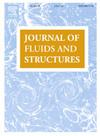不同形状钝体后面细长三角形旗子的动态气动弹性响应
IF 3.4
2区 工程技术
Q1 ENGINEERING, MECHANICAL
引用次数: 0
摘要
本研究探讨了位于不同横截面形状的钝体尾迹处的细长钢旗的气动弹性性能,即C形,倒C形(IC)和U形切割圆柱体,每种形状的径向腔切割角度为60°和120°,U形为180°。旗子位于距钝体不同距离处(G)。这个距离从0.5d到9d不等,其中d表示钝体的直径。采用浸入边界法进行的初步数值分析表明,每种构型的尾流形态不同。随后的风洞实验与这些发现一致,显示了一系列的不稳定状态。对于“c型”钝体,在间隙距离为3d至9d时,旗面出现颤振,而在较近距离(0.5d至2d)时,没有观察到极限环振荡(LCOs)。相比之下,对于“ic型”钝体,切割角度强烈影响旗扑动动力学,其中60°切割圆柱体表现出最明显的不稳定性。随着切角的增大,不稳定区变窄。“u型”钝体导致不对称尾迹相互作用,允许旗在更近的间隙距离(G = 0.5d - 2d)中振荡,在G = 0.5d处观察到亚临界分岔,这在其他地方没有观察到。在较大间隙距离(G = 3d ~ 9d)下,“u”型钝体尾迹下的颤振起始时间明显早于其他钝体形状。总的来说,这项研究强调了钝体形状和间隙距离对旗帜气动弹性行为的综合作用,为设计低雷诺数下高效的基于颤振的能量收集器提供了见解。本文章由计算机程序翻译,如有差异,请以英文原文为准。
Dynamic aeroelastic response of a slender triangular flag behind bluff bodies of varying shapes
This study explores the aeroelastic performance of a slender steel flag positioned in the wake of bluff bodies with different cross-sectional shapes, namely, C, inverted C (IC), and U shaped cut cylinders — with radial cavities cut at angles of 60° and 120° for each shape, and 180° for U shape. The flag is positioned at varying gap distances () from the bluff body. This distance varies from 0.5 to 9, where represents the diameter of the bluff body. A preliminary numerical analysis using the immersed boundary method reveals distinct wake patterns for each configuration. Subsequent wind tunnel experiments align with these findings, showing a range of instability regimes. For the “C-type” bluff body, flutter in flag occurs at gap distances between 3 and 9, while no limit cycle oscillations (LCOs) are observed for closer distances (0.5 to 2). In contrast, for the “IC-type” bluff body, the cut angle strongly influences the flag flutter dynamics, with the 60° cut cylinder exhibiting the most pronounced instability. As the cut angle increases, the instability regime narrows. The “U-type” bluff body results in asymmetric wake interaction, allowing the flag to flutter even in closer gap distances ( = 0.5 - 2), with a subcritical bifurcation observed at = 0.5, which is not observed elsewhere. The onset of the flutter is notably advanced under the wake of “U-type” bluff body as compared to other bluff body shapes at higher gap distances ( = 3 to 9). Overall, this study underscores the combined role of the bluff body shape and the gap distance on aeroelastic behavior of the flag, offering insights for designing efficient flutter-based energy harvesters at low Reynolds numbers.
求助全文
通过发布文献求助,成功后即可免费获取论文全文。
去求助
来源期刊

Journal of Fluids and Structures
工程技术-工程:机械
CiteScore
6.90
自引率
8.30%
发文量
173
审稿时长
65 days
期刊介绍:
The Journal of Fluids and Structures serves as a focal point and a forum for the exchange of ideas, for the many kinds of specialists and practitioners concerned with fluid–structure interactions and the dynamics of systems related thereto, in any field. One of its aims is to foster the cross–fertilization of ideas, methods and techniques in the various disciplines involved.
The journal publishes papers that present original and significant contributions on all aspects of the mechanical interactions between fluids and solids, regardless of scale.
 求助内容:
求助内容: 应助结果提醒方式:
应助结果提醒方式:


